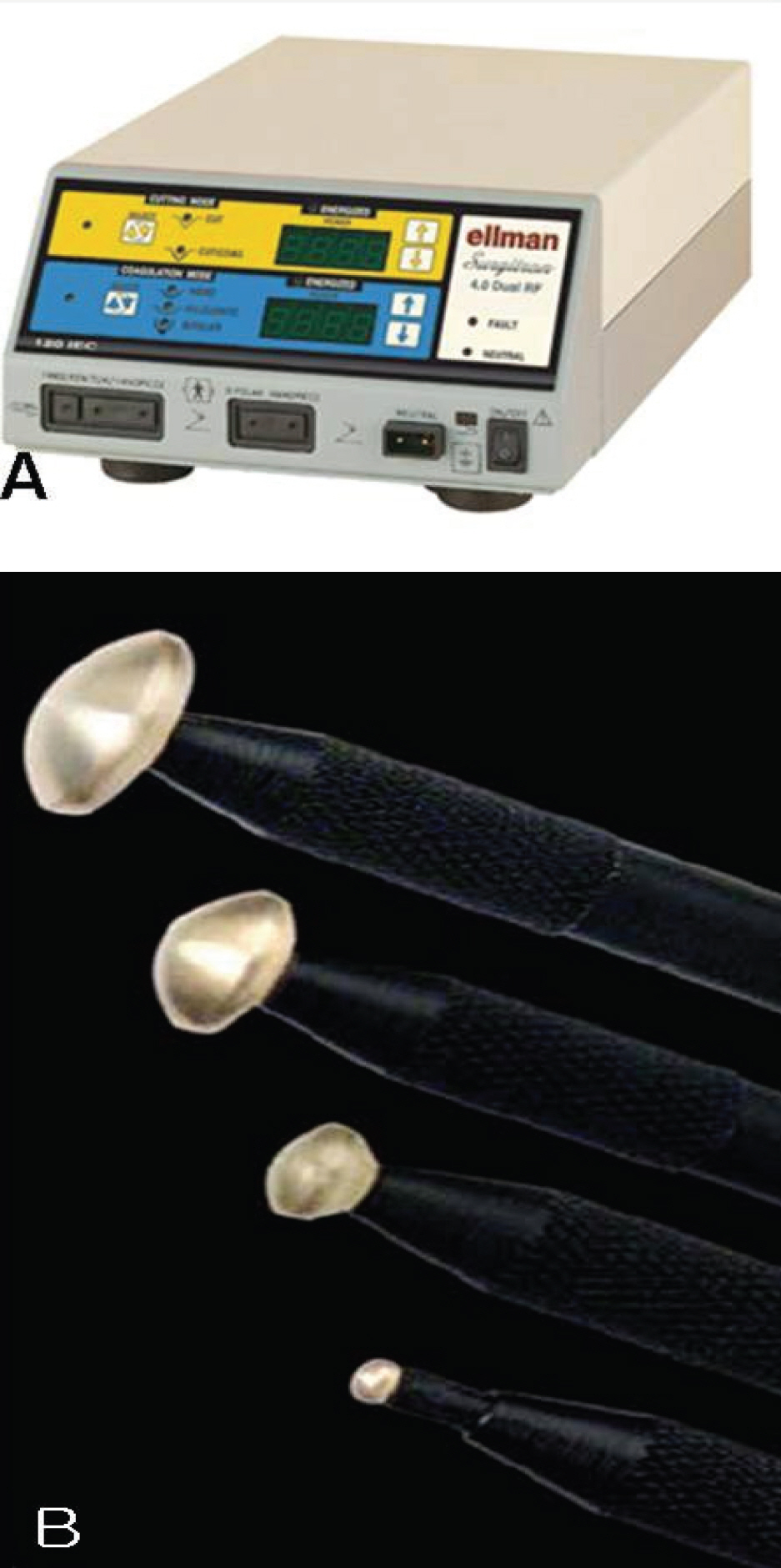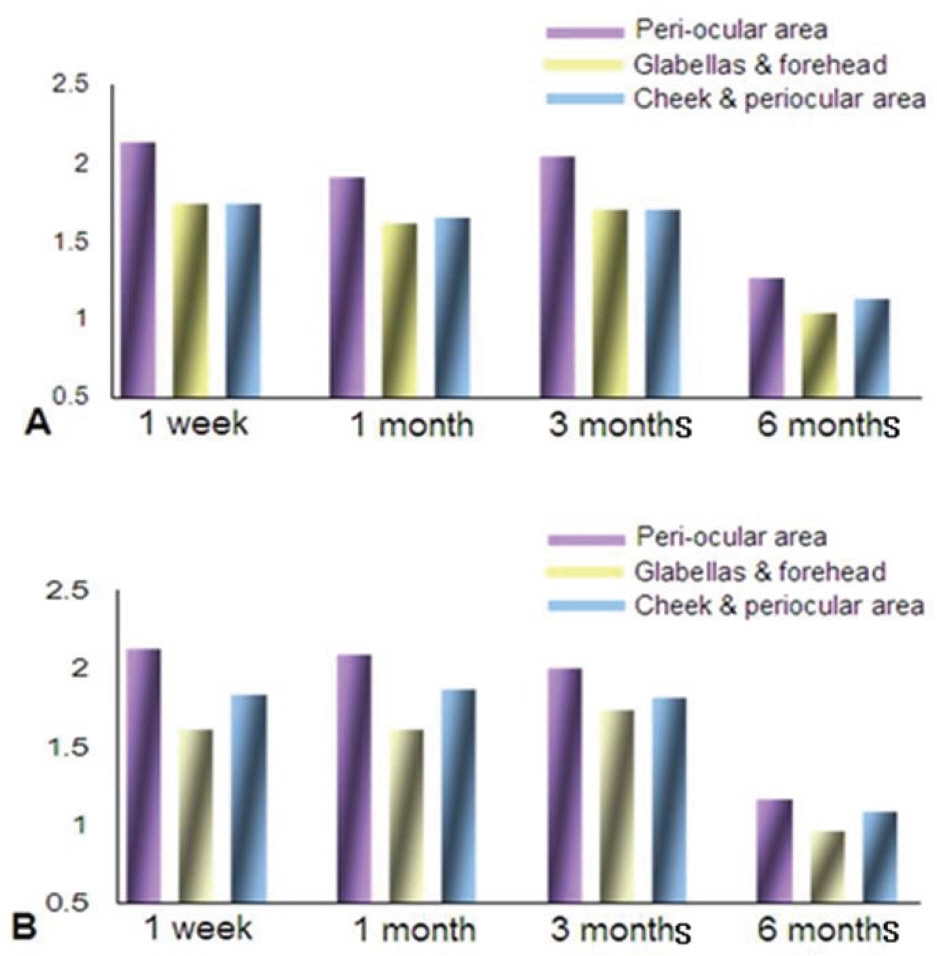J Korean Ophthalmol Soc.
2008 Nov;49(11):1711-1716.
Effect of Radiofrequency Device for the Treatment of Facial Rhytides
- Affiliations
-
- 1Department of Ophthalmology, East-West Neo Medical Center, KyungHee University College of Medicine, Seoul, Korea.
- 2Department of Ophthalmology, HanKang Sacred Heart Hospital, Hallym University, College of Medicine, Seoul, Korea.
- 3Department of Ophthalmology, Samsung Medical Center, Sungkyunkwan University College of Medicine, Seoul, Korea. ydkimoph@skku.edu
Abstract
- PURPOSE
To evaluate the effect of radiofrequency device for treatment of facial rhytides.
METHODS
Twenty-three patients of more than 50 years of age with Glogau photoaging scale type III, IV were included in this study. A Surgitron Dual Frequency device was used for facial rhytides, and a total of four treatment sessions spaced one week apart were performed. Clinical assessment was performed at one week, and at one, three, and six months after the last treatment session. The degree of objective & subjective improvement was determined using a five-step graded scale. Objective improvement was determined by two blinded assessors using before and after photographs. Subjective improvement was determined by questionnaire about rhytides improvement, patient satisfaction and prospect for another treatment session.
RESULTS
Significant improvement in facial rhitides was observed in the majority of patients until three months after treatment according to photography assessment. Self-estimation scores paralleled the photography scores and thus were also high until 3 months after treatment. Treatment of the periocular area was most effective.The procedure was associated with minimal downtime, and therewas no serious complication.
CONCLUSIONS
treatment for facial rhitides using the Surgitron Dual Frequency device is effective in a relatively short time. This technology is a relatively easy treatment method because of the minimal downtime and minimal risk associated its use, making periodic repetition efficient for treating facial rhytides.
Keyword
Figure
Reference
-
References
1. Holck DE, Ng JD. Facial skin rejuvenation. Curr Opin Ophthalmol. 2003; 14:246–52.
Article2. Fitzpatrick R, Geronemus R, Goldberg D, et al. Multicenter study of noninvasive radiofrequency for periorbital tissue tightening. Lasers Surg Med. 2003; 33:232–42.
Article3. Zelickson BD, Kist D, Bernstein E, et al. Histological and ultrastructural evaluation of the effects of a radiofrequency- based nonablative remodeling device: A pilot study. Arch Dermatol. 2004; 140:204–9.
Article4. Green HA, Drake L. Aging, sun damage and sunscreens. Clin Plast Surg. 1993; 20:1–6.
Article5. Fisher GJ, Wang Z, Datta SC, et al. Pathophysiology of premature skin aging induced by ultraviolet light. N Engl J Med. 1997; 337:1419–28.
Article6. Monheit GD, Chastain MA. Chemical peels. Facial Plast Surg Clin North Am. 2001; 9:239–55.7. Freedman BM, Rueda-Pedraza E, Waddel SP. The epidermal and dermal changes associated with microdermabrasion. Dermatol Surg. 2001; 127:1031–33.
Article8. Fitzpatrick RE. Maximizing benefits and minimizing risk with CO2 laser resurfacing. Dermatol Clin. 2002; 20:77–86.
Article9. Sadick NS. Update on non-ablative light therapy for rejuvenation: A review. Lasers Surg Med. 2003; 32:120–8.
Article10. Hardaway CA, Ross EV. Non-ablative laser skin remodeling. Dermatol Clin. 2002; 20:97–111.
Article11. Ruschiani A, Curinga G, Menichini G, et al. Nonsurgical tightening of skin laxity : A new radiofrequency approach. J Drugs Dermatol. 2007; 381–6.12. Burns AJ, Holden SG. Monopolar radiofrequency tissue tightening-How we do it in our practice. Lasers Surg Med. 2006; 575–9.
Article13. Friedman DJ, Gilead LT. The use of hybrid radiofrequency device for the treatment of rhytides and lax skin. Dermatol Surg. 2007; 33:543–51.
Article
- Full Text Links
- Actions
-
Cited
- CITED
-
- Close
- Share
- Similar articles
-
- Treatment of Facial Rhytides with Long-pulsed Er:YAG Laser(CO3)
- Treatment of Skin Laxity and Facial Wrinkles with Combinationof Radiofrequency and Infrared Light
- Persistent idiopathic facial pain treated with botulinum toxin and pulsed radiofrequency of infraorbital nerve – a case report
- A Case of Clonic Facial Spasm Treated with Percutaneous Radiofrequency Lesions
- Radiofrequency Coagulation around stylomastoid Foramen in 18 patients with Hemifacial Spasm




